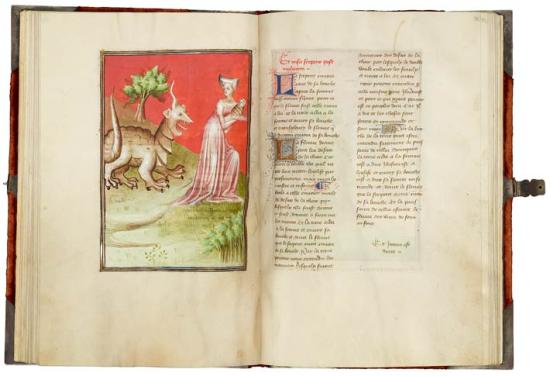
Apocalypse, with commentary, in French
Illuminated by the eponymous Master of the Berry Apocalypse
Purchased by Pierpont Morgan, 1910
The beast of the Apocalypse pursues a woman above whose head is inscribed L'eglise. Symbolizing the Church, this woman is purposefully not dressed in the period's luxurious houpeland. Instead, she wears only the traditional cote hardy. With its tight sleeves (worn here without tippets) and bodice but voluminous, trailing skirt, it is very much like the cotes hardy worn by the women in the previous section. Her headgear, too, is quite basic: double veils draped atop hair coiled over her ears.
Luxury in a Time of Madness
In 1392 King Charles VI suffered the first of forty-four bouts of madness that would cripple his reign. During a lull in the Hundred Years' War, strife between France and Burgundy erupted into civil war. This domestic crisis was sparked by the 1407 assassination of Charles's brother by Duke John of Burgundy. In 1419 the duke, in turn, was murdered by supporters of the crown. During these tumultuous times, fashion reached unbelievable heights of luxury.
Men's and women's fashions were dominated by a new garment, the houpeland. Men's houpelands featured enormous sleeves and a skirt ranging from full length to crotch level. The pourpoint remained popular, albeit often finely embroidered and equipped with large sleeves. Accessories included fancy baldricks (sashes) and belts—both sometimes hung with bells. Tall bonnets or chaperons, often tied into imaginative shapes, completed the look.
Women's houpelands were always full length, with bombard or straight sleeves. The simpler cote hardy, with its voluminous skirt and tight upper body, continued to be worn. Women began to wear their hair in temples, a double-horned coif surmounted by veils or a tubular burlet.
